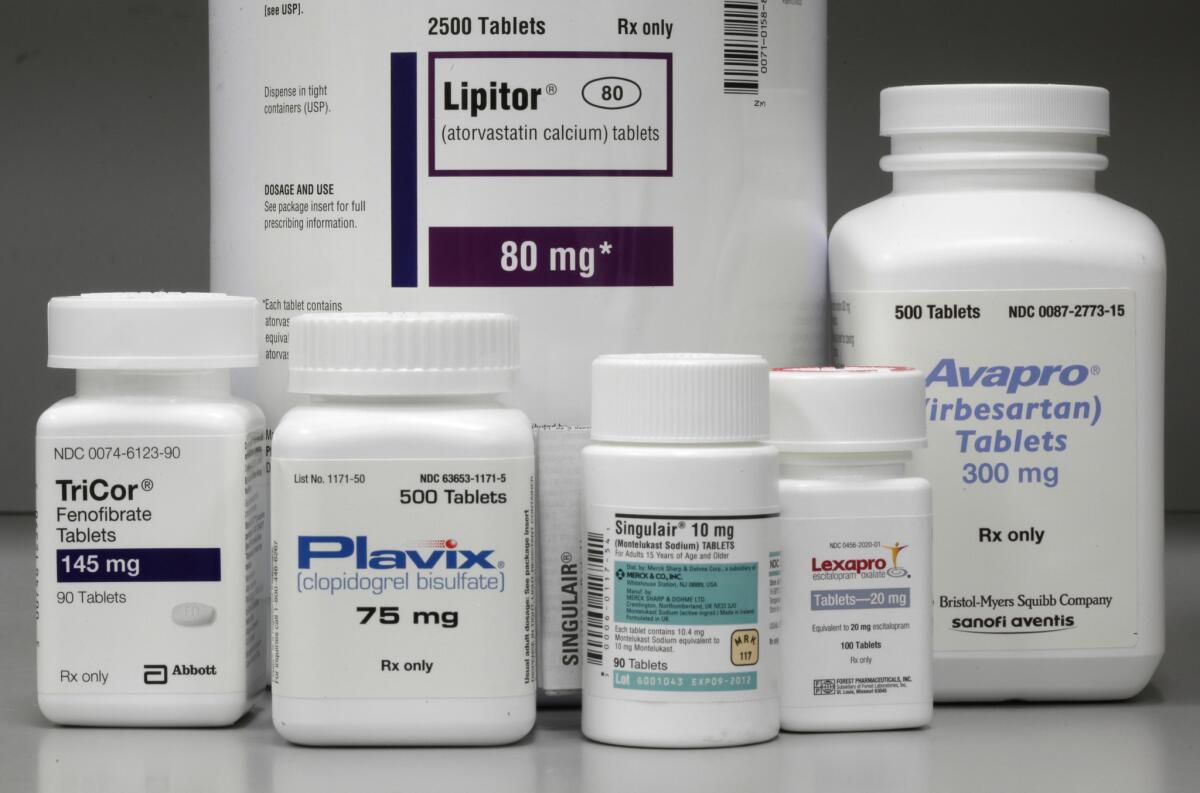Editorial: Why are drug prices soaring? Policymakers aren’t sure. It’s time they find out

- Share via
The growth in U.S. healthcare spending has slowed considerably in recent years, with one notable exception: prescription drugs. The amount spent on prescriptions has climbed sharply over the last 2 ½ years, driven in part by consecutive years of double-digit price increases. It’s not just a handful of blockbuster drugs that are draining wallets; it’s higher costs for all categories of drugs, including generic medications that have been on the market for years.
Whether that’s a problem depends on whether you’re buying medicines or selling them. Drugmakers argue that their products consistently account for less than 10% of all healthcare spending and that prescription medications are extending lives, improving the quality of life and, in some cases, curing diseases once thought to be incurable. Their critics retort that actual spending on prescription drugs is considerably higher, accounting for about one-sixth of all personal healthcare expenses. They also argue that there’s no justification for hiking the price of a drug whose value to patients hasn’t increased and that may not be more effective than older, less expensive medications. Meanwhile, consumers are facing ever-rising deductibles and co-payments, which force them to pay out of their own pockets for much of the increase in their prescription drug bills. According to the Kaiser Family Foundation, nearly one-fourth of the consumers who take prescription drugs say they have trouble affording them.
Politicians have talked about how important it is to rein in drug costs, but there’s no easy way to do so. Federal patent law gives drugmakers a temporary monopoly over the market for their products, which enables them to raise prices without fear of having competitors offer identical versions for less. Having the government cap prices could lead pharmaceutical companies to limit production and shift investments into product lines with larger profit margins. And requiring insurers to cover more of the cost of prescription drugs would almost certainly lead to higher premiums.
Before policymakers decide what to do, they need more information about how much is actually being spent on prescription drugs and why costs are rising. State Sen. Ed Hernandez (D-West Covina) has proposed a modest step in that direction; his bill (SB 1010) would require health insurers, which already have to reveal to state regulators detailed projections of hospital and physician costs, to include in those annual reports more information about what they’re spending on prescription drugs.
According to the Kaiser Family Foundation, nearly one-fourth of the consumers who take prescription drugs say they have trouble affording them.
Specifically, the measure would require insurers to report the average wholesale price of the 25 most frequently prescribed drugs, the 25 drugs on which the most money was spent and the 25 drugs with the highest price increases that year. The state would then be required to compile the data into a “consumer-friendly report that demonstrates the overall impact of drug costs on health care premiums.” Large group plans would also be required to disclose how much of their premiums and premium increases were attributable to various categories of prescription drugs, as well a comparison between prescription drug increases and other expenses. Drug manufacturers, in turn, would be required to give more advance notice and a fuller explanation when they impose double-digit price increases or introduce a drug that costs more than $10,000 a year.
Not surprisingly, biomedical and pharmaceutical companies oppose the bill. Requiring advance notice of price increases could lead pharmacies to stockpile drugs before the price changes, potentially causing regional shortages, the opponents contend. They also argue that it would paint an inaccurate picture because it ignores how rebates lower drug costs, and how prescriptions can lower spending on hospitalizations and other forms of care.
Yet it’s impossible to tally the costs that patients avoid; the only thing we can measure for certain is the cost of the care they do receive. On that front, the bill could conceivably tap the brakes on prescription drug price hikes by spurring health insurers, prescription-drug benefit managers and health plan administrators to find less expensive alternatives to costly meds. The entire industry is under pressure to slow the growth of costs anyway, which is why insurers, policymakers and healthcare regulators are looking for ways to encourage doctors and hospitals to deliver more bang for the buck. This bill could fill one piece of that puzzle by giving the public a better understanding of which drug costs are rising, and why.
Follow the Opinion section on Twitter @latimesopinion and Facebook
More to Read
A cure for the common opinion
Get thought-provoking perspectives with our weekly newsletter.
You may occasionally receive promotional content from the Los Angeles Times.










